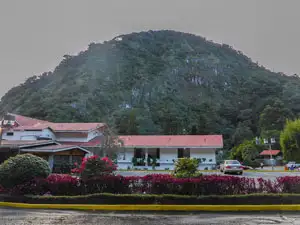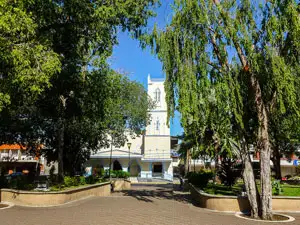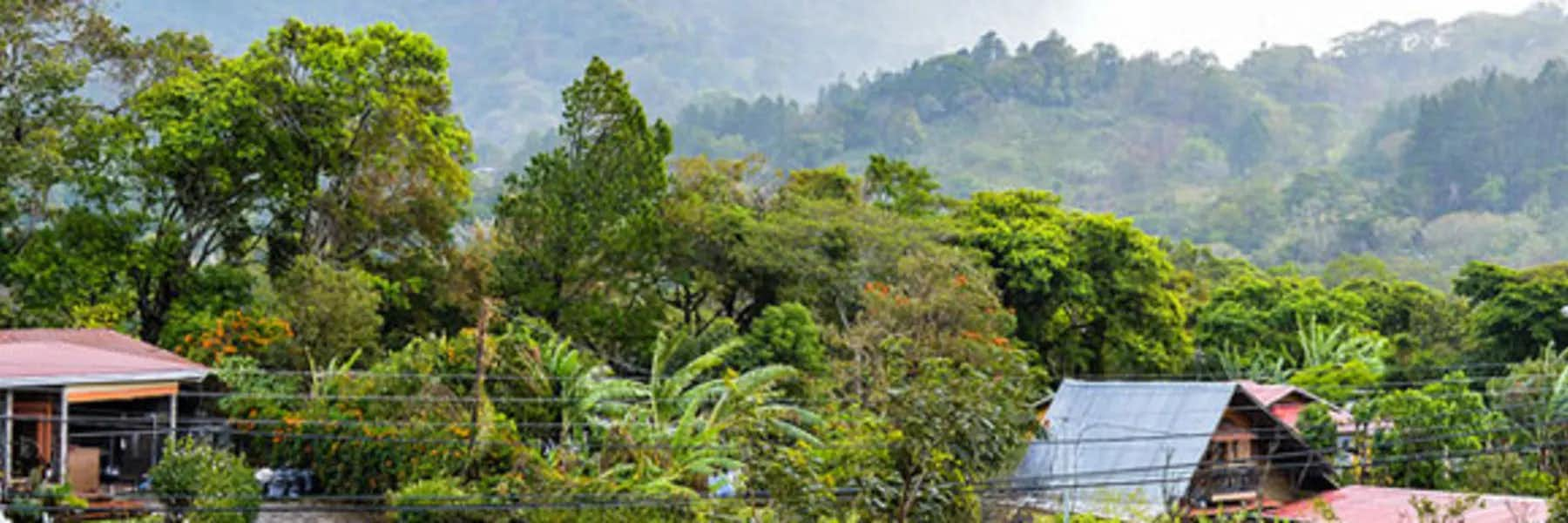The first time I saw Chiriquí Province I was enchanted. Although I was born and raised in New Jersey, I’m a country girl at heart and Chiriquí felt like home. My husband Al and I had rented a car to tour Panama in our quest for a new place to live. Having traveled throughout Central America, Panama was our pick due to its warm climate, low cost of living, developed infrastructure, and economic and political stability. We came back to stay in 2009, made our home in Chiriquí, and I’m still awed by the stunning scenery.
Chiriquí is one of 10 provinces in Panama and it borders Costa Rica to the west. Mostly rural, the landscape is among the most scenic in the country, with mountains defining the skyline. Acres of fruits and vegetables thrive in the rich volcanic soil, while cattle and horses laze in verdant pastures. The capital city of David is a bustling commercial hub undergoing a serious growth spurt.
A tour of Chiriquí Province will take you from Panama’s highest point—11,440 feet at the peak of Baru Volcano—to sea level and sandy beaches along the Gulf of Chiriquí. You’ll find 20,000-plus expats living throughout the province. Whether you prefer the beach or the mountains; living in town or out in the country; bright sunshine or cool cloud cover; Chiriquí offers you a choice…
Boquete—Land of Eternal Spring
The near-perfect climate is one of the main reasons as many as 12,000 expats now call the town and district of Boquete home. Its elevation of 3,940 feet on the eastern slope of Baru Volcano means normally cool temperatures around 80 F in the daytime and 60 F at night, with frequent misty rain called bajareque.
The village sits in a bowl-like depression, split by the rushing Caldera River. The surrounding hillsides are dotted with homes. Several loop roads head from town up into these communities and back down, so the area is interconnected and accessible.
Boquete is known for its natural beauty and has an unexpected alpine quality. Also tucked into the hillsides among the exotic flowering plants are coffee plantations and orange groves.
The village itself is small, with a central park surrounded by stores and services to meet basic needs. Since it is a tourist destination there are plenty of hotels, B&Bs, hostels, and spas, along with a wide range of restaurant options, from local fare to gourmet meals. One of my favorite spots is Sugar & Spice, an expat-owned bakery and café with delicious sandwiches and European-style breads, where lunch costs about $6.
What really sets Boquete apart is the people of the community: a relaxed mix of Panamanians, expats from North America and Europe, and other visitors from around the world. All this combined energy means there’s always something to do here. Civic and volunteer groups have established a fabulous library, a thriving art enclave, a lively music scene, and much more. Whatever your hobby there’s probably a club to join: woodworking, photography, knitting, bird watching, painting, hiking…you name it, they’ve got it.
There is also the Boquete Community Players Theater and Event Center, where you’ll find not only plays, but a year-round weekly market, where vendors arrive to sell all manner of goods. An informative meeting follows in the auditorium. This is the place to see and be seen, and no other market and meeting like it exists in Panama. This level of organization and dedication among expats and locals around town has also brought about the annual Boquete Jazz and Blues Festival, with international performers, as well as the yearly Boquete Flowers and Coffee Fair, situated at a fairground devoted to this week-long event.
Volcan and Cerro Punta—Panama’s Bread Basket
On the western slope of Baru Volcano, the towns of Volcan and Cerro Punta are famous for producing much of Panama’s food. Volcan shares the fresh highland climate of Boquete, while Cerro Punta is even cooler and wetter, at an elevation of 6,562 feet.
The highway that winds uphill towards Volcan is lined with dairy farms, plant nurseries, poultry barns, and spectacular vistas across the landscape. The town is in open country, spreading out toward the looming volcano in one direction, and the border with Costa Rica in the other. Beyond town the road climbs upward, past horse stables and mountain streams, to the village of Cerro Punta. Along the way vendors sell bags of their fresh produce and the local favorite, fresh strawberries with cream.

Volcan is an agricultural center, with supermarkets, hardware stores, farm supply centers, and more. There is a growing expat presence here, and the area appeals to those who prefer a slower pace and a less structured social life. The main gathering point for expats is a restaurant called Mana, which hosts a small weekly market on Friday mornings. Groups tend to center more around outdoor activities, and there’s a hiking club, horseback riders group, tai chi class, garden club, and a volunteer-run recycling center. This small expat community is easygoing and welcoming.
Cerro Punta has few foreign residents, mostly due to the wetter climate and lack of amenities. It is worth a visit though, as it is the home of a spectacular thoroughbred horse stable and the starting point of the hiking trail that traverses Baru Volcano. It is also where you will find Los Quetzales Ecolodge and Spa, a great place to go for a healthy, organic lunch, before wandering through their delightful grounds.
Caldera, Potrerillos, Boqueron—the Moderate Midlands
The midland region of Panama is a largely undeveloped and overlooked area that stretches from west to east in the foothills below the volcano, and consists of numerous small towns with a far-flung expat population. With a climate warmer and drier than the highlands and cooler and fresher than the lowlands, for some this is the perfect location.
Caldera and Los Molinos sit on either side of the highway that connects Boquete to the city of David. The road runs along the top of a ridge here, with a dramatic canyon dropping off on either side. This extraordinary setting has led to a number of housing developments with custom homes, townhouse condos, and duplexes. With easy access to both Boquete and David, expats who live in this area feel they have it all in a peaceful yet convenient setting.
“We have the best of Chiriquí here,” says Jerry Knezic, who rents a home in Boquete Canyon Village near Caldera. “Our view is awesome, it is so private and quiet here, and we can get to Boquete or David in about half an hour. We have great neighbors and lots of parties. What more would you want?”
The highway splits at Dolega, a well-established local town and home of expat-owned book store, The Book Mark, and Chiriquí Storage and Flea Market. The left fork of the highway takes you to Potrerillos Abajo (lower) and Potrerillos Arriba (upper). This rural area is known for its poultry farms and orange groves, with little in the way of a proper town. The scenery is lovely, however, with cattle pastures defined by rock walls built with volcanic boulders that spewed out of Baru eons ago. It’s an ideal location for a small farm or ranch, with plenty of space in the countryside, while still being close to town.
Between the highway to Boquete and the highway to Volcan lies a large, loosely defined district known as Bugaba, that includes the towns of Boqueron and Sortova and farther north, Buena Vista and Cuesta de Piedras. These are rural villages with no more than a few stores, an elementary school, and a bus stop. The climate, flora, and vistas vary depending on their elevation, and they all represent other areas to explore.
Richard Staigg, a former sailor, has lived in Boqueron for over six years. “Just about everything a person could need is right here in Chiriquí,” he says, “specifically, David, with shopping, banking, and fairly easy access to Panama City, which links one to the world. My neighbors are some of the kindest, most open and just plain salt of the earth people I’ve met anywhere. And some of the best coffee in the world is grown locally.”
David, the Provincial Capital
I live just north of David in a rental house in a typical middle-class neighborhood where my husband and I pay $400 a month for rent. David is Panama’s third largest city and it sprawls out west to east along the Pan-American Highway, and south to the mangrove estuaries along the coast. The compact downtown area of central David is a fun place to explore side streets on foot, and browse through the local shops. Residential areas mingle with business and commercial centers as the city fans out to the highway, which is lined on both sides with shopping centers, restaurants, hospitals, schools, and automotive centers.

David is a hive of activity. As the seat of government it is where official business takes place. Numerous colleges and universities bring in students from all over the province. It is the transportation hub of the region, with an international airport and a major bus terminal, as well as being the commercial and shopping center of the province.
This is also the healthcare hub of the region, with two private and two public hospitals, offering a full range of medical services. Hospital Chiriquí, is in the process of building a major addition that will nearly double its size. One of the public hospitals specializes in maternity and infant care, while the other is in the midst of an expansion. Numerous clinics and specialty services round out the facilities in David, offering affordable and accessible primary care. A typical doctor’s visit will cost between $10 and $50, no appointment necessary.
Lying in the lowlands, David is truly tropical and always hot, still, many people get by without air conditioning.
What draws expats to David and the surrounding sub-divisions is the convenience of having all you need just a few minutes away. I live five minutes from one of the nicest supermarkets in town, which sits in a large shopping center with a hardware store, department stores, electronics stores, a wine and liquor store, and more.
Norma and Turk Humphries own a home with a swimming pool in an older neighborhood on the north side of David. “We have the privacy we like with the location of the property and the house works for us. The neighborhood is convenient to all the basic necessities (shopping, banking, hospitals, restaurants, theaters, etc.). We enjoy the weather and the small town living in David.”
The one downside to David for expats is the absence of a social network. It’s impossible to estimate the number of expats in the area. There are a few small groups who get together regularly around town, but no central meeting place for expats, as there is in Boquete or Volcan.
Low-Cost Living in Chiriquí—From $1,000 a Month
I surveyed a number of expats (couples and singles) who live in Chiriquí and found that for routine living expenses, monthly budgets range from $1,000 to $2,500 per month. This typically would not include items such as insurance, car or home repairs, medical procedures, travel, or other annual expenses (such as taxes). The biggest variable is housing, and rents are higher in and around Boquete than elsewhere in the region.
“I could live on $1,200 a month and live pretty well,” says Mary Ellen Watts. “I own my home and car. I usually spend a bit more than that, but I travel back to the states twice a year, and go out to eat often. For $2,000 a month you would be living high on the hog as they say.”
For my own part, we spend around $1,600 a month, and that includes our rent and medical expenses.
Some items vary too widely to estimate, such as medications, entertainment and eating out, and cell/smart phone service. But in general, the cost of living is lower so your money goes further.
If you own your home and have no monthly housing expense (property taxes and homeowner’s insurance are very low), you can expect to spend $1,000 to $2,000 a month in Chiriquí, depending on your lifestyle.
Paying rent will increase your monthly expense and will vary depending on where you live. Rent for a two-bedroom home will start at $400 in David, Volcan, and the midlands. In Boquete, rents are higher, starting at $650 and going up from there.
Las Lajas, La Barqueta, Boca Chica: The Beaches
Our tour of Chiriquí Province ends at the shoreline and the Gulf of Chiriquí, which opens onto the Pacific Ocean. This coast is known for its fantastic offshore fishing, with tuna, marlin, mahi mahi, sea bass, snapper, and more running in the local waters. The water is always warm so you can swim year-round. Numerous small islands and coral reefs are included in the Gulf of Chiriquí National Marine Park, most of them easily reached from Boca Chica, where boats are for hire. Despite its obvious attractiveness, the coastline here is undeveloped. You won’t see any high-rises, condo developments, theme parks, or water sports vendors. You will see a sandy beach with a wide tidal range, typically small waves, and very few people.
Las Lajas is about an hour-and-a-half drive east of David, south of the Pan-American Highway. You’ll find a village with a couple of small stores, and a road that continues on through pastures to the beach. Here, make-shift kitchens serve up fried fish and ceviche with cold beer and sodas.
Las Lajas is a great choice for a day at the beach, or an overnight at the small resort. But its remote location means it is far from shopping, business, and expat activities.
Boca Chica is a tiny fishing community that has seen recent interest from fishing and boating aficionados, and now boasts several resort properties. These businesses cater to offshore fishermen who come down on vacation and boaters who anchor in the protected cove. Water taxis shuttle clients among the islands to spend a day at a secluded beach, snorkel a protected reef, or arrive at an exclusive, private boutique inn. Because of its close proximity to David, and potential for more growth, Boca Chica is the perfect place for considering a business investment or even rental property.
The easiest beach to get to is La Barqueta, about a half an hour drive southwest of David, past fields with cattle along shaded roads. A large resort sits right at the end of the road. Quiet and deserted during the week, the shaded shoreline fills up on weekends and holidays with families.
A gated community of custom homes extends to the west along the shoreline, with a smaller development stretching to the east. Some residents are here year-round, while others leave their northern homes to spend the winter in the tropics. “Most days we have the beach all to ourselves,” says Bob Simpson, who lives there with his wife Kathy, “and it’s an easy drive into David.”
A three-tower condominium complex is in development at La Barqueta, with the first tower pre-sold at $80,000 per unit. This is the first project of its kind along the Chiriquí coast.
The western-most beach area in Chiriquí is close to the border with Costa Rica. The town of Puerto Armuelles was once a thriving port, shipping bananas and other fruits all over the Americas. When labor troubles shut down the fruit packing companies the town lost its livelihood. Today, a new oil shipping port is being developed and some feel this may be the next growth area. It’s about an hour west of David, and a few adventurous expats have settled there.
Related Content
Boquete, Panama: The Town Of Perpetual Spring
